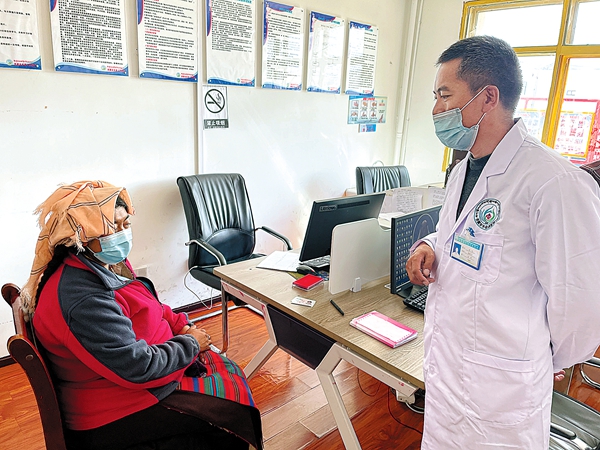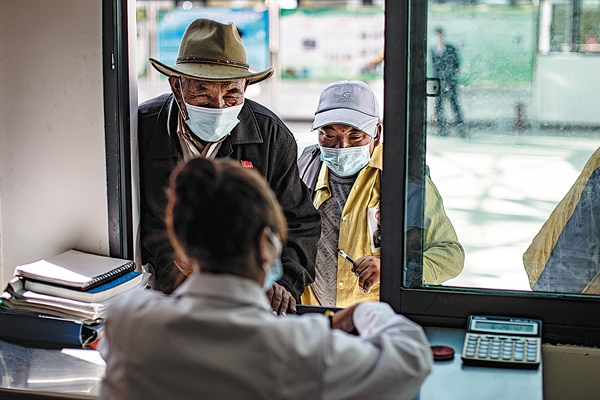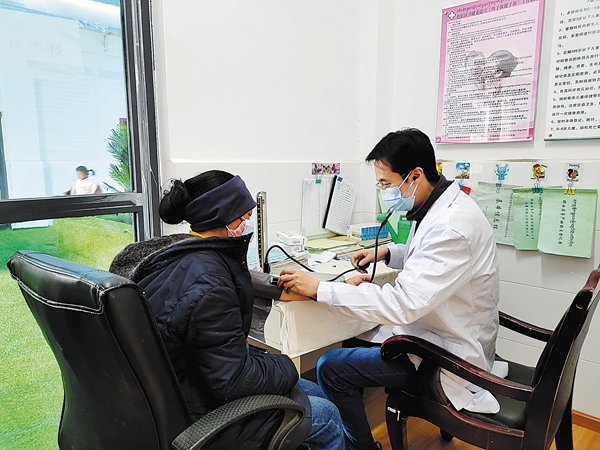
Surgeon Dorje talks to Drolma, an expectant mother who is about to give birth to her fourth child at Amdo County People's Hospital in Nagchu.[Photo by Deng Zhangyu/China Daily]
Medical workers in Tibet have updated facilities to provide treatment but conditions remain harsh, Deng Zhangyu reports.
When surgeon Dorje came across Drolma, an expectant mother who had just arrived at Amdo County People's Hospital in Nagchu city in the Tibet autonomous region by motorbike, he arranged everything quickly for the woman who was going to give birth to her fourth baby.
Though the 45-year-old doctor is in charge of the surgery department, he has experience in delivering babies as there is a shortage of doctors and medical care on the plateau.
"The medical care has improved dramatically in the past three years. In 2018, we still used stoves to burn cow dung for heating in wards," says Dorje.
Now, well-decorated buildings installed with modern equipment have been put into operation. A newly built delivery room with an inbuilt heating system is in place.
The delivery room is the busiest place in the hospital as more and more locals, most of whom are nomadic, choose to give birth at the hospital instead of at home, says Dorje, who is also director of the hospital.
It's common for a typical nomadic family to raise four to six children. They were used to giving birth at home, partly because there were few qualified clinics and hospitals to offer a safe delivery and partly because they couldn't afford the medical costs.
Drolma had her first three babies at the yurt her family lives in, which is about 100 kilometers away from Amdo county. Since conditions of the county's medical care have improved, she decided to give birth to her fourth child at the hospital. It took the couple seven hours to drive there by motorbike.

Patients see a doctor at a clinic in Serchen village in Amdo county.[Photo provided to China Daily]
To encourage safe delivery, all the costs of childbirth are covered. After the delivery, each mother will get 1,450 yuan ($233.9) from the local government, says Dorje.
According to an official government report on May 22, the death rate among women in childbirth has decreased from 5,000 per 100,000 seven decades ago to 48 per 100,000 as of 2021, and the infant mortality rate has dropped to 7.6 per thousand-both record lows.
The hospital where Dorje works assigned a whole floor of its new building to the obstetrics department this year to meet the increasing demand of women giving birth.
Set up in 1966, the hospital had only about 20 wards in 2018. Now the number of wards has increased to 107. Altogether, 44 medical workers provide medical care in 27 departments.
"Changes and upgrades happen every year," says Dorje, who has worked as a doctor in Nagchu city for 24 years.

Obstetrician Liu Yangchen (center) operates on an expectant mother in critical condition at Nagchu People's Hospital in the Tibet autonomous region, where equipment and buildings have been improved in the past few years.[Photo provided to China Daily]
After graduating from Tibet University in Lhasa, Dorje began his career as a doctor at a small clinic in a village in Nagchu city in 1997.Being the only doctor, he had to deal with various medical demands. However, due to an extreme shortage of medicine and the poor condition of the clinic, he failed to satisfy many of his patients.
Then, the nomadic people living in Nagchu city, which is more than 4,500 meters above sea level, could only walk, ride a horse or a motorbike to see a doctor. And a well-conditioned hospital was often hundreds of kilometers away.
"When patients arrived at a hospital after several days of traveling, they often missed the best time for treatment," recalls Dorje.
Currently, Tibet has 1,642 medical institutions covering all townships and villages. Well-equipped hospitals have been set up in counties.
Although medical services have been greatly improved, the number of doctors is far from sufficient, says Dorje.

Doctor Liu Yangchen carries out regular free consultation in a village in Nagchu.[Photo provided to China Daily]
The average altitude of Amdo county is 5,200 meters above sea level. The thin concentration of oxygen makes life here harder and slower than that in the plains. One has to struggle with frequent headaches and harsh weather-winter lingers for half a year with heavy snow.
The doctors are busy all year round. In summer, he and his team have to do physical examinations-funded by the government-covering all residents to check out potential high-altitude diseases, such as pulmonary and cerebral edema.
When winter comes, Dorje will be busy dealing with surging traffic accidents caused by harsh weather. The county is on a key route for trucks transporting materials to Lhasa, the capital of Tibet.
Asked why he kept working here for decades instead of going back to his hometown of Shigatse city, which has an elevation much lower than Amdo county, he says he feels needed here by his patients, a group who "wholeheartedly trust him and are grateful to him".
Dorje is glad to see the changes and improvements in his hospital funded by the region's government as well as cooperative hospitals outside Tibet.
In the past decade, the Amdo County People's Hospital has been sponsored by the General Hospital of Eastern Theater Command in Nanjing in East China's Jiangsu province. From 2019 to 2020, the hospital in Nanjing sent 30 doctors and nurses to work in Amdo and invested 7.5 million yuan in buying medical equipment and building new wards for the county hospital.

Liu (center) offers classes for Tibetan doctors in Nagchu.[Photo provided to China Daily]
In the early 1990s, the central government began its medical aid project in the region. Each hospital in Tibet would cooperate with medical institutions outside Tibet and get funded in terms of staff and money.
Liu Yangchen, an obstetrician from the First Affiliated Hospital of Dalian Medical University in the coastal city of Dalian in Liaoning province, began his work in Nagchu People's Hospital in March. Altogether there are 18 medical staff for the cooperative project Liu attends.
Liu will work for one year and a half in Nagchu. Although the 40-year-old has stayed here for five months, he is still fighting with headaches caused by a shortage of oxygen.
"My family worry about my health. But they still support my decision," says Liu, a father of two.
In 2015, Liu traveled to Tibet for holiday and learned that the region is in need of doctors. When the aid project came up, he took part in it without hesitation.
As an experienced doctor, Liu has a full schedule every day. He has to treat deliveries, offer classes for local doctors, upgrade plans for the obstetrics department and fulfill them.
"To be honest, I'm stressed because I feel it's my mission to offer good classes to local staff and good medical service to patients here," he says.
He once helped eight women to give birth to babies in half a day. To accommodate the surging number of expecting mothers, Liu changed his office into a ward.
"I hope my efforts can make a little difference here," says Liu, standing in a delivery room that looks almost the same with those in Dalian's hospital.

